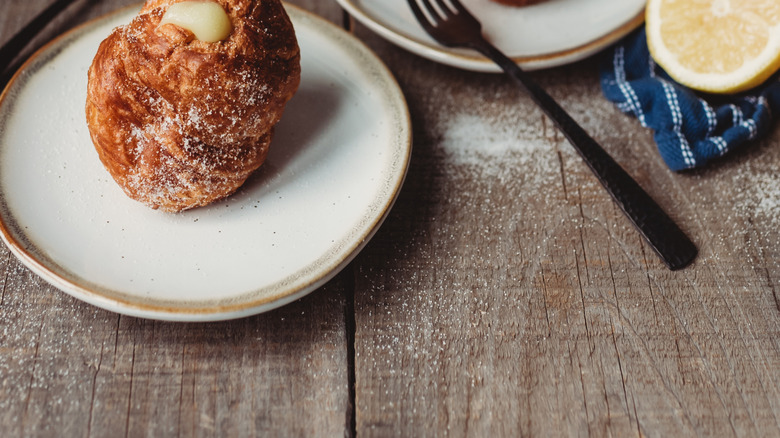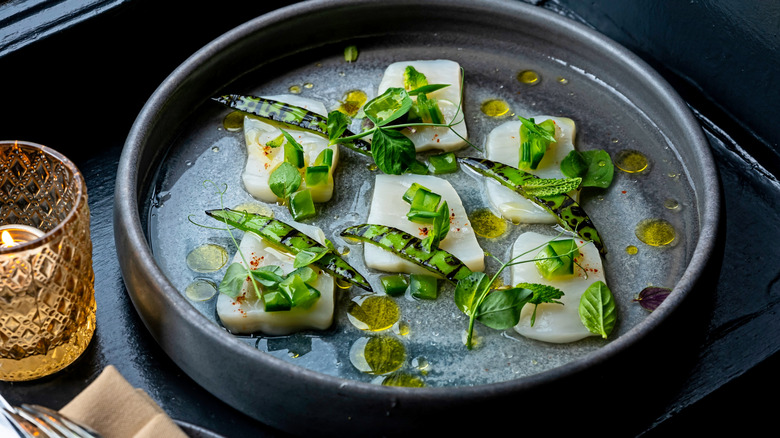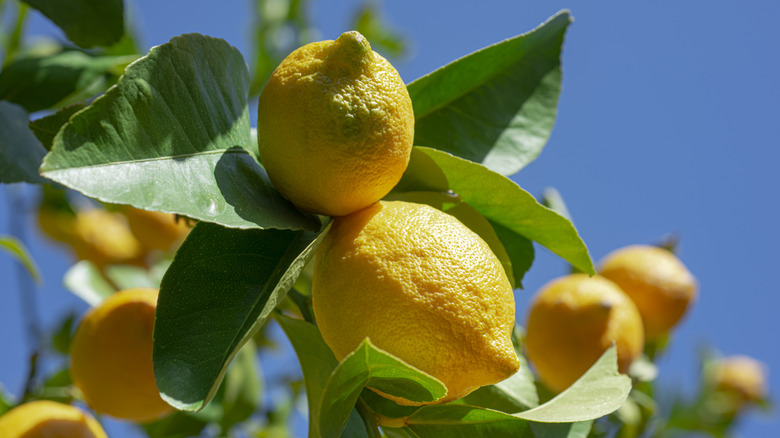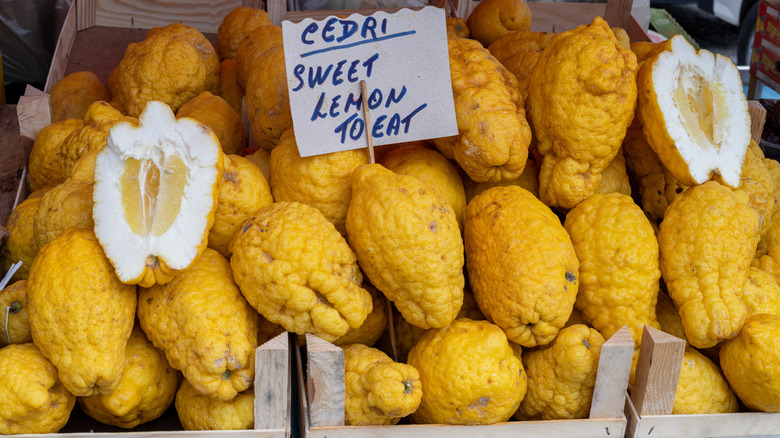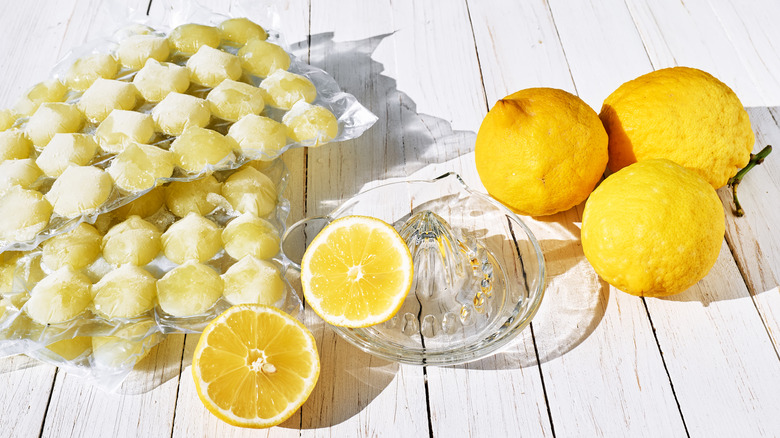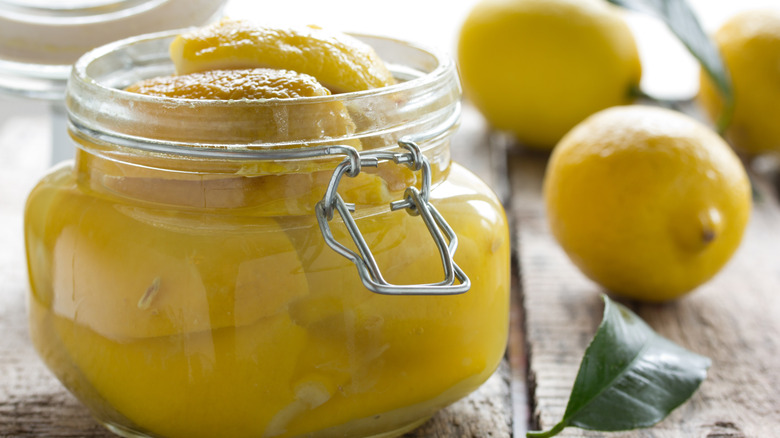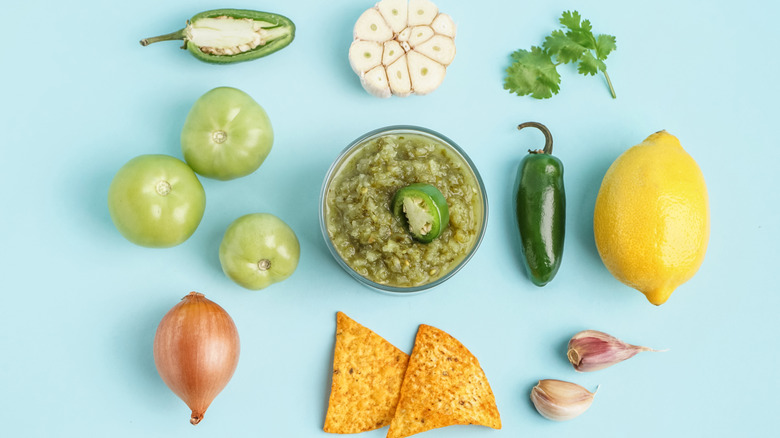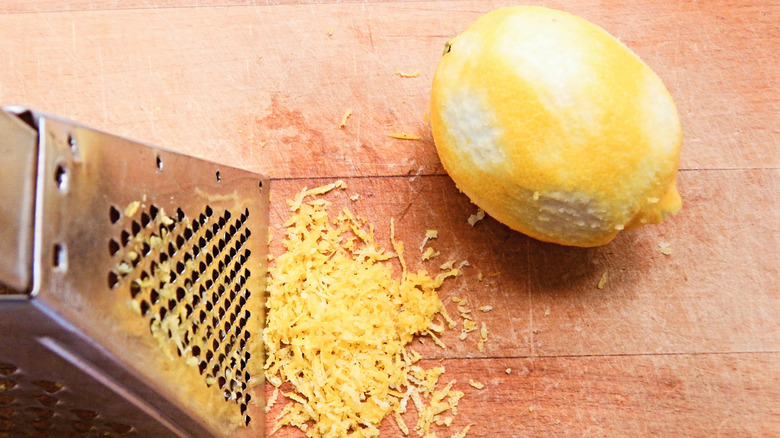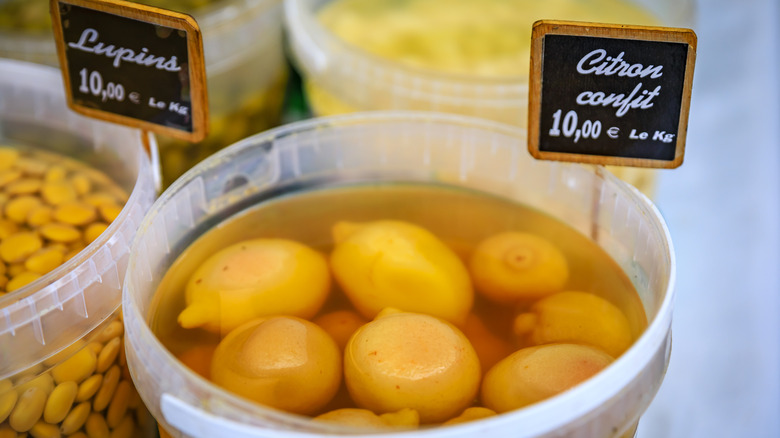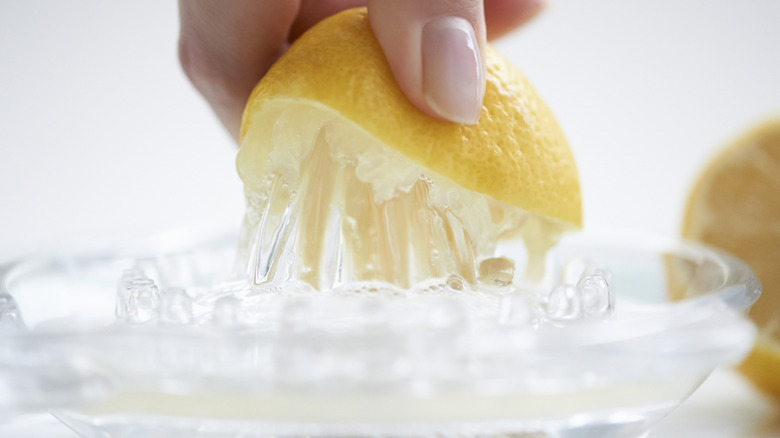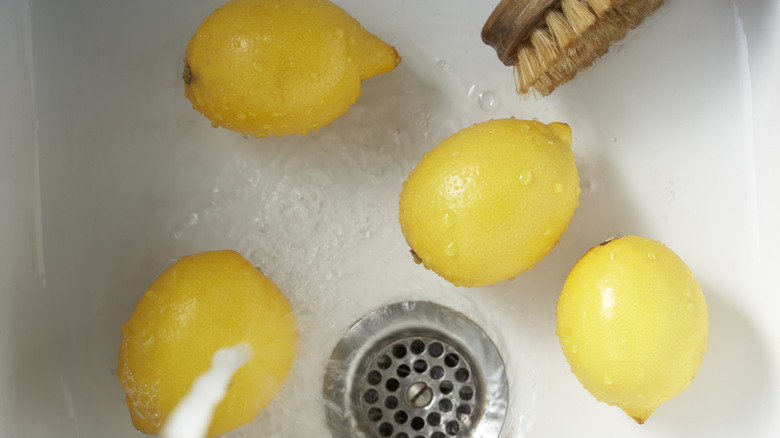Mistakes You're Making When Cooking Or Baking With Lemons
We may receive a commission on purchases made from links.
As far as miracle ingredients go, lemon takes the cake on bringing wondrous flavor to both sweet and savory dishes. Yet even a magical element like lemon can lead a casual cook or baker astray. It can be a pain to juice and zest, and as a highly acidic ingredient, special considerations need to be made to ensure that things don't get mouth-numbingly sour.
Luckily, there's plenty of culinary wisdom on the citrus subject. For the cooking know-how, I turned to Danielle Alvarez, the chef behind the modern classic cookbook, "Always Add Lemon." An American chef now based in Australia, Alvarez learned her craft in her mother's Florida-based kitchen that saw a lot of traditional Cuban food and later at Alice Waters' famed Chez Panisse. The one constant that spoke to her throughout her education was the delicious power that lemon could bring to any recipe.
For my part, I'll offer up some hard-won baking tips. While I was the managing editor at a baking magazine, I peeled, candied, and juiced many a lemon for my desserts. Along the way I learned some key tips on how to get the best out of that tangy, bright yellow citrus.
Saving lemons only for lemon-based desserts
You may think that lemon only has a place in citrus-centric desserts like lemon meringue pie and lemon bars, but consider the many other fruit desserts that are begging for a hit of acid. Strawberry cake, blueberry biscuits, and raspberry pie all welcome a taste of lemon. In fact, we've long pushed the idea that lemon curd brightens berry pie right up, and that same citrus touch can come from a more simple source, like a tablespoon or two of lemon juice or a teaspoon of freshly grated lemon zest stirred right into a filling or batter. Even a lemon glaze would be an out-of-this-world addition to any berry-studded muffin or scone.
And then there are the desserts that receive lemon as a surprise complement. A rich ricotta cheesecake gets a sophisticated twist when lemon zest is folded into the graham cracker crust. Creamy rice pudding or even a decadent cream brûlée welcomes that acid to cut through all the sweetness. Once you consider what lemon will bring to any dessert item, the opportunities are endless.
Using lemon juice when vinegar would work better
Yes, there are times when lemon juice doesn't help but instead hurts your dish's overall integrity. As chef Danielle Alvarez notes, "There's a lot of places where, if you're looking for acidity, vinegar makes a bit more sense." This includes some soups and stews, like a creamy bisque, which benefits from a sharp sherry vinegar rather than a spritz of lemon juice. Lemon juice also has a distinct taste, while vinegar represents a more neutrally flavored acid. If the dish has and needs to maintain a strong flavor, opt for vinegar as the lemon juice may overpower the dish.
And then there are the times that you can use lemon juice but need to tread carefully. This can be particularly true for crudo, a raw seafood dish dressed simply with oil and an acid, usually citrus juice or vinegar. When drizzled with lemon juice, crudo can turn into ceviche, as the lemon juice will cook it. You can protect your raw seafood by coating it in olive oil before introducing the lemon juice.
Forgetting to treat lemon like a seasonal fruit
The most common mistake cooks make with a lemon? According to chef Danielle Alvarez, it's forgetting that this grocery store staple is truly a seasonal ingredient. With a season really running from winter to early spring, lemons are so sweet and ripe that the whole lemon can be used in recipes. "In that time of year ... I'm chopping them up whole, I'm chopping up the zest, I'm chopping up the inside," she says. She also loves using whole lemon segments to create an out-of-this-world lemony brown butter sauce, a recipe you can find in her cookbook "Always Add Lemon."
As for the parts of the lemon that are typically considered trash, Alvarez claims the seasonal sweetness helps even the pith lack its typical bitterness. This allows her to add whole lemons to her sauces, salads, and more without some of that extra peeling and squeezing prep. Another benefit of using in-season lemons is just an overall superior flavor, with intensely aromatic rinds and balanced juice. Out of season, Alvarez is careful to make up for the less-than-perfect lemons by adding sweetness to compensate for the excess sourness and zesting the rind carefully to keep out any bitter pith.
Not using the whole lemon for your pie
Speaking of using the whole lemon in your cooking, you should also consider making a classic lemon pie with the entire lemon. This bit of baking wisdom comes from an old Shaker lemon pie recipe I tried that counsels bakers to macerate thinly sliced lemons before turning them into a wildly aromatic filling. Reported to be an invention of Ohio Shakers, a religious sect from the 19th century, the pie focused on making sure that not one part of produce was wasted in the baking process (with the exception of the seeds).
In more modern recipes, this can be likened to the blender lemon pie formula, where eggs, sugar, butter, a bit of vanilla, and whole lemons are blitzed into a ready-to-bake custard filling. Both methods will yield a pie that isn't just tangy but borderline floral in its lemony flavor, thanks to the generous helping of rind. It's probably best to do this hack when lemons are in season and at their sweetest. Buying a seedless variety would also cut down on prep time. Beyond typical pies, consider taking this whole lemon baking process to other pastries like slab pieces, hand pies, or a lemony homemade pop tart.
Sleeping on Meyer and Cedro Lemons
Many grocery shoppers take it for granted that there are numerous lemon varieties available at the market. For chef Danielle Alvarez, there's no greater lemon variety to invest in than Meyer lemons. She first encountered this special type of citrus when cooking in California and hasn't looked back since. As a hybrid variety, Meyer lemons are sweet and thin skinned and have barely any of that typical bitter pith. "They're a beautiful balance between really aromatic sweetness and sourness," Alvarez says. Her favorite ways to use it are in sweet lemon tarts or mixed into a salsa verde (more on that later).
If you're making a trip to Europe anytime soon, Alvarez also called out Italian cedro lemons (aka citron in English) as being one of the tastiest types as well. Sliced thinly and served as a kind of lemon carpaccio, it's one of the few lemons that can be enjoyed raw. Unlike the Meyer lemons, cedro lemons have a very large pith area and thick skin. While the juicy flesh of the lemon is still sweet and delicious, most cooks prize it for the aromatic zest and pith, using it to create salads, candied peels, marmalade, and risotto.
Neglecting to freeze your lemon juice and zest
Many people don't know that lemon juice and zest both freeze very well and taste relatively fresh for months. In fact, it's one of the best way to store leftover lemon juice and zest when you're looking to save as much of the in-season sunshine as you can. To start, line an ice cube tray with plastic wrap and then ladle tablespoons of fresh lemon juice into the compartments. Once frozen, you can seal these chunks of lemon juice in a zip=top bag or wrap them further in plastic wrap. This pre-portioned lemon juice should last in the freezer for up to six months.
As for the zest, you can follow a similar formula, packing teaspoons or tablespoons worth of fresh zest into an ice cube tray lined with plastic. Keep in mind that a fine zest works best for packing into an ice cube tray, but large strips, like the ones you'd use in syrups or cocktails, will freeze just fine in a zip-top bag. Once grated and frozen, your zest should keep for about three months in the freezer.
Forgetting to use preserved lemon
For those who haven't yet tried preserved lemons, you're in for a treat. The pickled condiment is essentially made of lemons that have been packed in salt and their own juice and allowed to brine until they practically melt. The skin becomes super soft and edible, and the lemons can last for much longer in the pantry. Though it's often confined to North African, South Asian, and Middle Eastern cuisine, preserved lemon can work almost anywhere regular lemon zest is called for, chef Danielle Alvarez says. Consider it a more concentrated, perfumed version of lemon with an added note of salty umami.
To see its effect on your cooking, start by adding some preserved lemon to your favorite braise or chicken stew. It also brings incredible complexity to vinaigrettes, marinades, and pasta sauces, adding a signature floral-salt flavor that can't be mimicked. Of course, as these lemons are macerated in large quantities of salt, cooks should be careful about how much of the condiment they add to any one dish. Start with adding a teaspoon or two to the mix, taste, then add more if you believe the dish can take it.
Not adding lemons to your salsa
Lemons might sound like an unconventional choice for salsa, but chef Danielle Alvarez swears that cooks haven't lived until they've tried creating a bright lemony salsa verde. She discovered this recipe when working at Chez Panisse, the famed restaurant that put farm-to-table dining on the map. She described the recipe as follows. Whole, chopped Meyer lemons would soak with freshly diced shallots. After a bit, the lemon-shallot medley would be combined with fresh herbs, seasoning, and high-quality olive oil. When it's served over a fried filet of fish, Alvarez claims the overall taste is "a revelation."
Of course, lemon juice has long been an excellent addition to salsas, but limes have often been the favored citrus. Cooks should look beyond just adding in the juice, opting to incorporate the tender flesh and rind of an in-season Meyer lemon to completely change the way your favorite dip tastes. Consider trying this lemon-forward approach to aromatic pico de gallo or even a creamy batch of guacamole.
Including the lemon pith
When you zest your lemon, you need to make sure you're not including any of the white spongy part of the skin, aka the pith. Why? Well, it's not because the pith is actually bitter all on its own. Instead, the bitterness comes when the pith and zest are mixed and mashed together. The two release acid and enzymes that make the overall flavor taste very bitter. If your zest is going to have a gentle journey, such as simply being added to the top of a risotto dish or flecking a glaze, you don't have to worry about the pith as much.
But when it comes to almost every other project in the kitchen, the zest will not have a gentle journey. It could be muddled together in a lemonade pitcher or beaten into a cream cheese frosting or thoroughly mixed with peppercorns to make homemade lemon pepper seasoning. Whatever the harsh process, make sure there's very little pith involved in the equation. Admittedly, if you're baking or cooking in lemon season with ultra-thin skinned Meyer lemons, the pith will taste better. But all other times you should be wary of the lemon's pith.
Ignoring the pleasures of lemon confit
Lemons preserved in olive oil, or lemon confit, is a seriously underrated condiment in Danielle Alvarez's book. She particularly likes to use it when she wants a more subtle lemon flavor than what salty preserved lemon can give her. "Confit lemon is a beautiful way to incorporate lemon [flavor] without the heavy seasoning," she says. It works well in salads, as a fish topper, chopped and folded into a vinaigrette, or even served alongside a charcuterie board.
To make your own lemon confit, you can begin by placing sliced, seeded lemons in a Dutch oven, submerging them in high quality olive oil, and cooking everything at a gentle simmer for roughly 15 minutes. You can add other aromatics, including whole spices, salt, or sugar, to this mix, but even if it's just plain, you'll be impressed with the lemon confit condiment. As an added bonus, you can use a similar method to make lemon-infused olive oil. You'll just strain out the lemon pieces rather than keeping them preserved in the oil.
Juicing your lemons cold
Juicing can be the most frustrating part of creating a scrumptious homemade batch of lemonade or lemon curd. Knowing all the best ways to juice lemons is the only way to keep your sanity in check. Though people often store their lemons in the fridge to prolong their shelf life, they should wait until the lemons come to room temperature before juicing. Why? Cold lemons don't give up nearly as much juice as room temperature ones. One reason for this is that the fragile membranes that hold the lemon juice in get firmer at cold temperatures.
Some people who don't want to wait for their lemons to warm up on their own will instead microwave them for 20 seconds or so to get the juices going. Keep in mind that if you do any longer than the 20 seconds, your lemon could potentially explode, so consider adding on extra time in 5-second increments.
Still working with a stubborn lemon? Give it a firm roll on a hard surface like a granite kitchen top (this is sometimes called the rolling pin method) before juicing. This excess pressure will also help weaken the membranes of the lemon segments, not to mention burst open some of the juice sacs.
Not combining lemon and chocolate
Orange and chocolate get all the love, but Danielle Alvarez thinks that people who haven't tried lemon and chocolate are missing out. She first understood the incredible possibilities of the pairing when she dined at the Australian restaurant Brae. After a fine-tasting-menu dinner, Alvarez was treated to a lemon chocolate dessert that defied expectations. "It was like a warm chocolate mousse inside of a lemon cup — like he hollowed out the lemon and served [the mousse] inside of a beautiful fresh lemon," she says.
Why does this sweet pairing work so well? Like other citrus varieties such as oranges and limes, the acidic fruit tends to highlight the fruity notes within the chocolate. This is especially true when working with very high-quality chocolate that uses an intense concentration of cocoa. Usually, the darker the chocolate, the better it is for lemon, as the cocoa in those chocolates is more nuanced and robust. A milk chocolate bar can be too sweet for a nuanced pairing. White chocolate, too, can be a bit sweet, but it does have a neutral enough flavor that it won't fight against the lemon undertones.
Neglecting to properly clean your lemons
Many commercial lemons, as Danielle Alvarez notes, are coated in artificial wax to help make them last longer and withstand bruising in stores. Ironically, many citrus fruits produce their own natural wax coating, but this usually gets washed off during the harvesting process. Though this artificial wax coating is perfectly harmless and safe to eat, every grocery store lemon benefits from a proper scrub under cold water. Why? The rind is still a perfect place for bacteria and pesticides to hide.
Most people may wash their lemons fine, but they miss a crucial step: allowing the lemons to dry before zesting. The porous skin of the lemon will absorb water from the rinsing, making it slick and harder to zest and grate for your cooking purposes. If waxy grocery store lemons are still giving you doubts, try to go organic or locally grown. Better yet, invest in growing your own lemon tree if you've got the climate for it. "Once you have access to home-grown lemons, you'll realize how fragrant and incredible they can be [compared with] the waxed varieties that you find in the stores," Alvarez notes.

